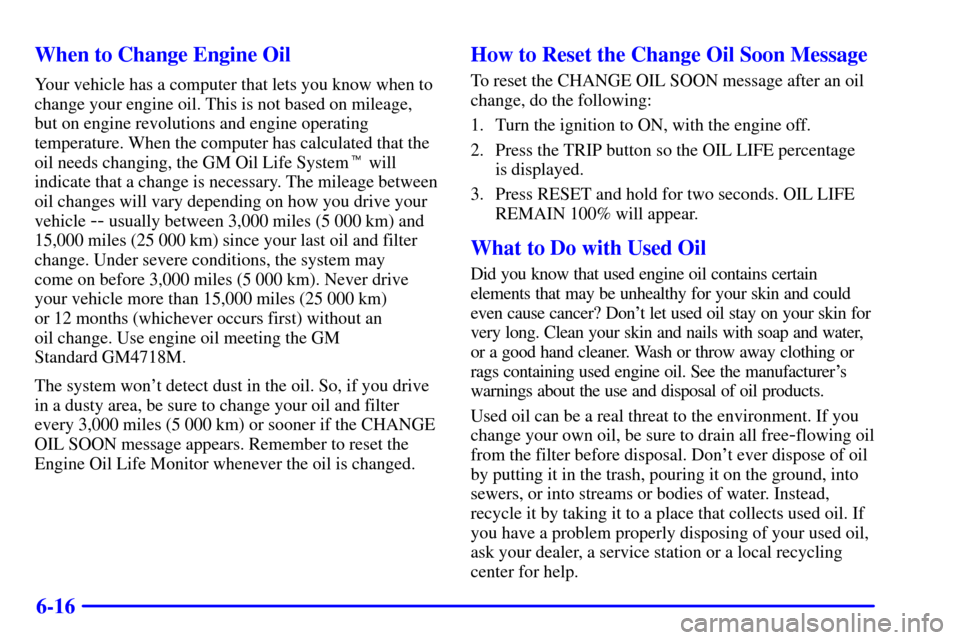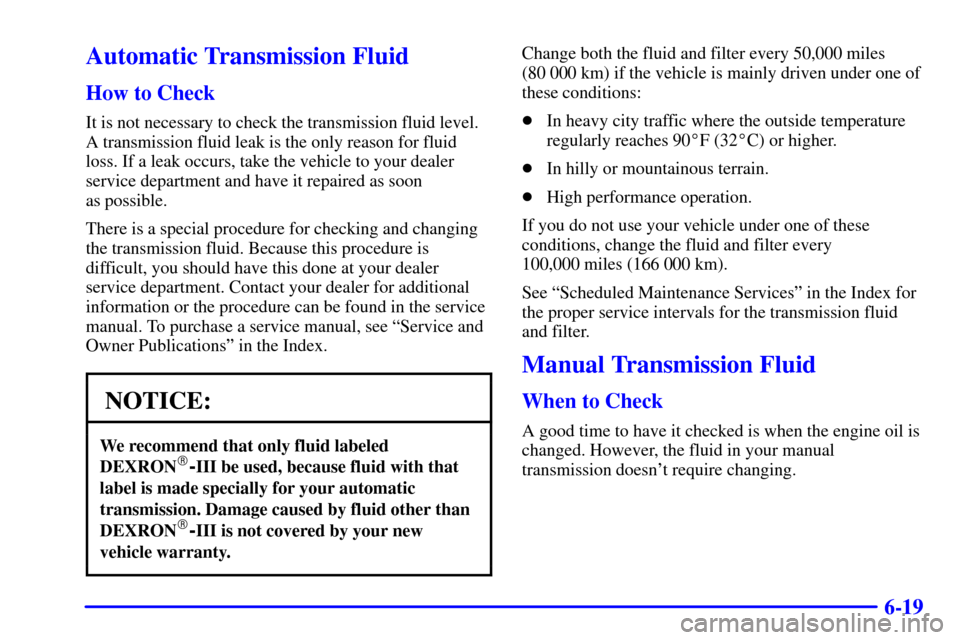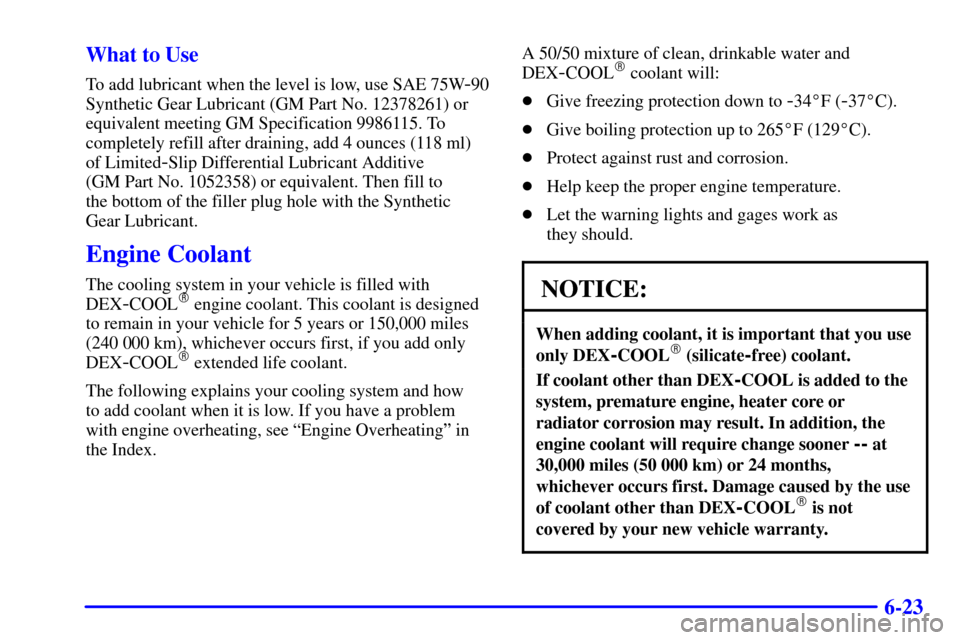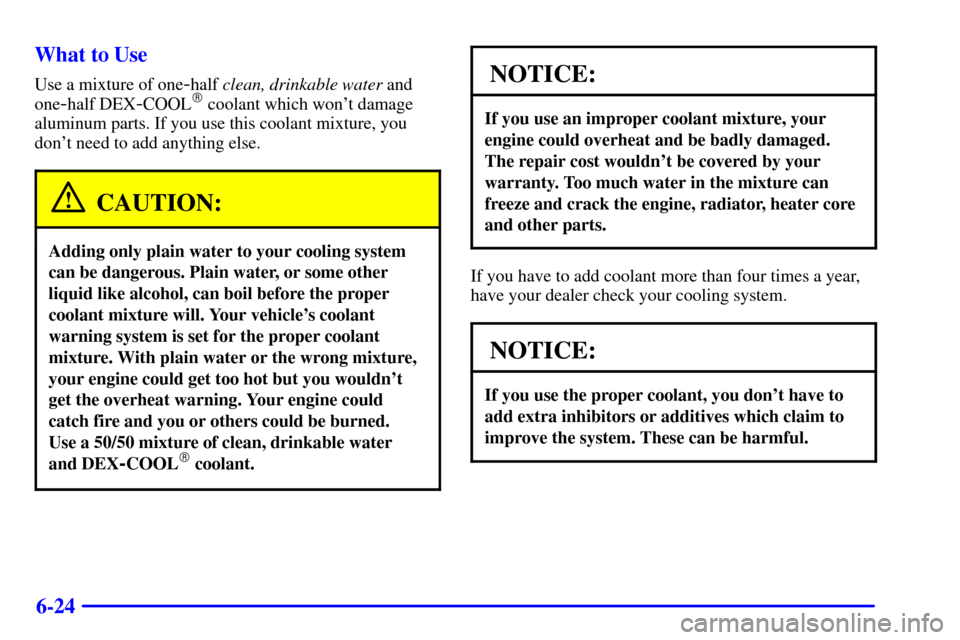Page 282 of 383

6-13
Pull out the dipstick and clean it with a paper towel or a
cloth, then push it back in all the way. Remove it again,
keeping the tip down.
When to Add Engine Oil
If the oil is at or below the ADD mark, you'll need to
add at least one quart of oil. But you must use the right
kind. This part explains what kind of oil to use. For
crankcase capacity, see ªCapacities and Specificationsº
in the Index.
See ªRacing or Other Competitive Drivingº in the index
for additional information on engine oil.
NOTICE:
Don't add too much oil. If your engine has so
much oil that the oil level gets above the upper
mark that shows the proper operating range,
your engine could be damaged.
The engine oil fill cap is
located on top of the valve
cover on the passenger's
side of the engine.
See ªEngine Compartment
Overviewº in the Index
for more information
on location.
Be sure to fill it enough to put the level somewhere in
the proper operating range. Push the dipstick all the way
back in when you're through.
Page 283 of 383
6-14 What Kind of Engine Oil to Use
Look for two things:
�GM4718M
Your vehicle's engine requires a special oil meeting
GM Standard GM4718M. Oils meeting this standard
may be identified as synthetic. However, not all
synthetic oils will meet this GM standard. You
should look for and use only an oil that meets
GM Standard GM4718M.
NOTICE:
If you use oils that don't have the GM4718M
Standard designation, you can cause engine
damage not covered by your warranty.
Page 284 of 383

6-15
�SAE 5W-30
As shown in the viscosity chart, SAE 5W
-30 is best
for your vehicle. However, you can use SAE
10W
-30 if it's going to be 0�F (-18�C) or above.
These numbers on an oil container show its viscosity,
or thickness. Do not use other viscosity oils such
as SAE 20W
-50.
Oils meeting these
requirements should also
have the starburst symbol
on the container. This
symbol indicates that the
oil has been certified by
the American Petroleum
Institute (API).You should look for this on the oil container, and use
only those oils that are identified as meeting GM
Standard 4718M and have the starburst symbol on the
front of the oil container.
Your vehicle's engine is filled at the factory with a
Mobil 1
� synthetic oil, which meets all requirements for
your vehicle.
Substitute Engine Oil: When adding oil to maintain
engine oil level, oil meeting GM Standard GM4718M
may not be available. You can add substitute oil
designated SAE 5W
-30 with the starburst symbol at all
temperatures. If temperatures are above 0�F (
-18�C),
you may substitute SAE 10W
-30 with the starburst
symbol. Substitute oil not meeting GM Standard
GM4718M should not be used for an oil change.
Engine Oil Additives
Don't add anything to your oil. The recommended oils
with the starburst symbol are all you will need for good
performance and engine protection.
Page 285 of 383

6-16 When to Change Engine Oil
Your vehicle has a computer that lets you know when to
change your engine oil. This is not based on mileage,
but on engine revolutions and engine operating
temperature. When the computer has calculated that the
oil needs changing, the GM Oil Life System� will
indicate that a change is necessary. The mileage between
oil changes will vary depending on how you drive your
vehicle
-- usually between 3,000 miles (5 000 km) and
15,000 miles (25 000 km) since your last oil and filter
change. Under severe conditions, the system may
come on before 3,000 miles (5 000 km). Never drive
your vehicle more than 15,000 miles (25 000 km)
or 12 months (whichever occurs first) without an
oil change. Use engine oil meeting the GM
Standard GM4718M.
The system won't detect dust in the oil. So, if you drive
in a dusty area, be sure to change your oil and filter
every 3,000 miles (5 000 km) or sooner if the CHANGE
OIL SOON message appears. Remember to reset the
Engine Oil Life Monitor whenever the oil is changed.
How to Reset the Change Oil Soon Message
To reset the CHANGE OIL SOON message after an oil
change, do the following:
1. Turn the ignition to ON, with the engine off.
2. Press the TRIP button so the OIL LIFE percentage
is displayed.
3. Press RESET and hold for two seconds. OIL LIFE
REMAIN 100% will appear.
What to Do with Used Oil
Did you know that used engine oil contains certain
elements that may be unhealthy for your skin and could
even cause cancer? Don't let used oil stay on your skin for
very long. Clean your skin and nails with soap and water,
or a good hand cleaner. Wash or throw away clothing or
rags containing used engine oil. See the manufacturer's
warnings about the use and disposal of oil products.
Used oil can be a real threat to the environment. If you
change your own oil, be sure to drain all free
-flowing oil
from the filter before disposal. Don't ever dispose of oil
by putting it in the trash, pouring it on the ground, into
sewers, or into streams or bodies of water. Instead,
recycle it by taking it to a place that collects used oil. If
you have a problem properly disposing of your used oil,
ask your dealer, a service station or a local recycling
center for help.
Page 288 of 383

6-19
Automatic Transmission Fluid
How to Check
It is not necessary to check the transmission fluid level.
A transmission fluid leak is the only reason for fluid
loss. If a leak occurs, take the vehicle to your dealer
service department and have it repaired as soon
as possible.
There is a special procedure for checking and changing
the transmission fluid. Because this procedure is
difficult, you should have this done at your dealer
service department. Contact your dealer for additional
information or the procedure can be found in the service
manual. To purchase a service manual, see ªService and
Owner Publicationsº in the Index.
NOTICE:
We recommend that only fluid labeled
DEXRON�-III be used, because fluid with that
label is made specially for your automatic
transmission. Damage caused by fluid other than
DEXRON
�-III is not covered by your new
vehicle warranty.
Change both the fluid and filter every 50,000 miles
(80 000 km) if the vehicle is mainly driven under one of
these conditions:
�In heavy city traffic where the outside temperature
regularly reaches 90�F (32�C) or higher.
�In hilly or mountainous terrain.
�High performance operation.
If you do not use your vehicle under one of these
conditions, change the fluid and filter every
100,000 miles (166 000 km).
See ªScheduled Maintenance Servicesº in the Index for
the proper service intervals for the transmission fluid
and filter.
Manual Transmission Fluid
When to Check
A good time to have it checked is when the engine oil is
changed. However, the fluid in your manual
transmission doesn't require changing.
Page 292 of 383

6-23 What to Use
To add lubricant when the level is low, use SAE 75W-90
Synthetic Gear Lubricant (GM Part No. 12378261) or
equivalent meeting GM Specification 9986115. To
completely refill after draining, add 4 ounces (118 ml)
of Limited
-Slip Differential Lubricant Additive
(GM Part No. 1052358) or equivalent. Then fill to
the bottom of the filler plug hole with the Synthetic
Gear Lubricant.
Engine Coolant
The cooling system in your vehicle is filled with
DEX
-COOL� engine coolant. This coolant is designed
to remain in your vehicle for 5 years or 150,000 miles
(240 000 km), whichever occurs first, if you add only
DEX
-COOL� extended life coolant.
The following explains your cooling system and how
to add coolant when it is low. If you have a problem
with engine overheating, see ªEngine Overheatingº in
the Index.A 50/50 mixture of clean, drinkable water and
DEX
-COOL� coolant will:
�Give freezing protection down to
-34�F (-37�C).
�Give boiling protection up to 265�F (129�C).
�Protect against rust and corrosion.
�Help keep the proper engine temperature.
�Let the warning lights and gages work as
they should.
NOTICE:
When adding coolant, it is important that you use
only DEX
-COOL� (silicate-free) coolant.
If coolant other than DEX-COOL is added to the
system, premature engine, heater core or
radiator corrosion may result. In addition, the
engine coolant will require change sooner
-- at
30,000 miles (50 000 km) or 24 months,
whichever occurs first. Damage caused by the use
of coolant other than DEX
-COOL� is not
covered by your new vehicle warranty.
Page 293 of 383

6-24 What to Use
Use a mixture of one-half clean, drinkable water and
one
-half DEX-COOL� coolant which won't damage
aluminum parts. If you use this coolant mixture, you
don't need to add anything else.
CAUTION:
Adding only plain water to your cooling system
can be dangerous. Plain water, or some other
liquid like alcohol, can boil before the proper
coolant mixture will. Your vehicle's coolant
warning system is set for the proper coolant
mixture. With plain water or the wrong mixture,
your engine could get too hot but you wouldn't
get the overheat warning. Your engine could
catch fire and you or others could be burned.
Use a 50/50 mixture of clean, drinkable water
and DEX
-COOL� coolant.
NOTICE:
If you use an improper coolant mixture, your
engine could overheat and be badly damaged.
The repair cost wouldn't be covered by your
warranty. Too much water in the mixture can
freeze and crack the engine, radiator, heater core
and other parts.
If you have to add coolant more than four times a year,
have your dealer check your cooling system.
NOTICE:
If you use the proper coolant, you don't have to
add extra inhibitors or additives which claim to
improve the system. These can be harmful.
Page 299 of 383

6-30
Checking Brake Fluid
You can check the brake fluid without taking off the cap.
Just look at the brake fluid reservoir. The fluid level
should be above the MIN mark on the reservoir. If it
isn't, have your brake system checked to see if there
is a leak.
After work is done on the brake hydraulic system, make
sure the level is between the MIN and MAX marks.
What to Add
When you do need brake fluid, use only DOT
-3 brake
fluid. Use new brake fluid from a sealed container only.
Refer to ªRecommended Fluids and Lubricantsº in the
Maintenance Schedule.
Always clean the brake fluid reservoir cap and the area
around the cap before removing it. This will help keep
dirt from entering the reservoir.
CAUTION:
With the wrong kind of fluid in your brake
system, your brakes may not work well, or they
may not even work at all. This could cause a
crash. Always use the proper brake fluid.
NOTICE:
�Using the wrong fluid can badly damage
brake system parts. For example, just a few
drops of mineral
-based oil, such as engine
oil, in your brake system can damage brake
system parts so badly that they'll have to be
replaced. Don't let someone put in the
wrong kind of fluid.
�If you spill brake fluid on your vehicle's
painted surfaces, the paint finish can be
damaged. Be careful not to spill brake fluid on
your vehicle. If you do, wash it off immediately.
See ªAppearance Careº in the Index.